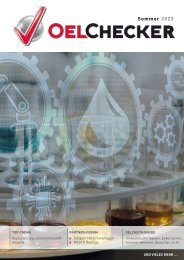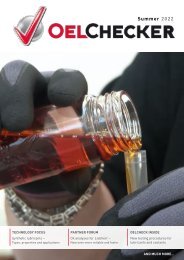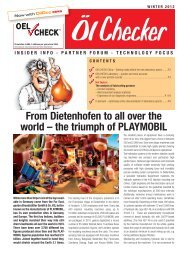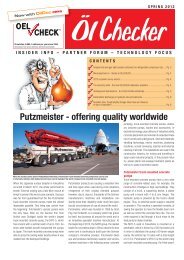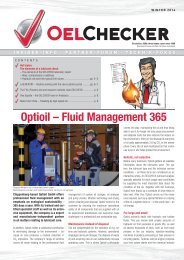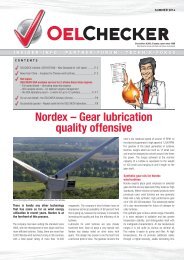OELCHECKER - Summer 2012
> Prokon wind turbines – optimum service and secure earnings > OELCHECK laboratory in the "workbench of the world" domain > The rappers from the OELCHECK alpine pastures > Optimised technology and perfect service for gas engines – August Storm > Hot Topics: > Viscosity – the single most important physical characteristic of any oil > Question time: Limit values > and much more...
> Prokon wind turbines – optimum service and secure earnings
> OELCHECK laboratory in the "workbench of the world" domain
> The rappers from the OELCHECK alpine pastures
> Optimised technology and perfect service for gas engines – August Storm
> Hot Topics:
> Viscosity – the single most important physical characteristic of any oil
> Question time: Limit values
> and much more...
You also want an ePaper? Increase the reach of your titles
YUMPU automatically turns print PDFs into web optimized ePapers that Google loves.
Viscosity-temperature behaviour<br />
When the temperature drops, an oil will always<br />
become thicker, i.e. will have a higher viscosity.<br />
When the solidifying point is eventually<br />
reached, the oil will become so thick that it can<br />
no longer move at all. On the other hand, when<br />
the temperature increases, the viscosity drops<br />
considerably. The oil can become extremely thin.<br />
These temperature-dependent changes must be<br />
taken into account when choosing a lubricant.<br />
Particular care needs to be taken since viscosity-temperature<br />
behaviour depends on the type<br />
of oil. Even oils with the same viscosity at, for<br />
example, 40°C can behave totally differently at<br />
0°C or 100°C.<br />
A temperature-dependent viscosity change will<br />
not be linear but can be calculated “double<br />
logarithmically”. Temperature differences of, for<br />
example, 10°C do not lead to identical number<br />
jumps in viscosity changes. The viscosity index<br />
(VI), which is calculated with the aid of kinematic<br />
viscosity measured at 40°C and 100°C, is<br />
used to describe an oil’s viscosity-temperature<br />
behaviour. This parameter allows the viscosity<br />
behaviour of various oils to be better compared<br />
based on temperature. The calculation method<br />
described in ISO 2909 was developed approximately<br />
60 years ago. In terms of the viscosity<br />
index, the worst mineral oils known at the time<br />
were awarded a VI of 0, and the mineral oils with<br />
the best viscosity-temperature behaviour were<br />
awarded a VI of 100. At the time, there were no<br />
synthetic or multigrade oils. Nowadays, viscosity<br />
can be influenced by so-called VI improvers or<br />
synthetic oils to such an extent that the viscosity<br />
index now extends far beyond 100. The following<br />
standard values illustrate how high the viscosity<br />
index can be taken by modern oils:<br />
Oil or fluid type Viscosity Index<br />
Mineral oil ~ 95 - 105<br />
Multigrade oil ~ 140 - 200<br />
PAO oil ~ 135 - 160<br />
Ester ~ 140 - 190<br />
Vegetable oil ~ 195 - 210<br />
Glycol ~ 200 - 220<br />
Silicone oil ~ 205 - 400<br />
A simple and widely-used method for visualising<br />
viscosity-temperature behaviour is the viscositytemperature<br />
diagram (VT diagram) according<br />
to Ubbelohde/Walther. Using the mathematical<br />
conversion (double logarithmical calculation), VT<br />
behaviour can be approximated to such a degree<br />
using a straight line through two points (usually<br />
at 40°C und 100°C), that viscosity at all other<br />
temperatures can be read from the diagram.<br />
Different fields of application can be illustrated<br />
using the VT diagram. HLVP oil with a higher<br />
viscosity index can, for example, cover a broader<br />
temperature range.<br />
Viscosity-pressure behaviour<br />
Oils also become thicker with increased pressure.<br />
Viscosity-pressure behaviour is also a lubricantspecific<br />
parameter which can however, for the<br />
most part, be neglected since, at pressures below<br />
400 bar, it is virtually insignificant. The change in<br />
viscosity due to an increase in pressure of 100<br />
bar is disproportionately less than that due to an<br />
increase in temperature of 10°C. Designers of highperformance<br />
hydraulic systems and components<br />
always consider the influence that pressure has on<br />
viscosity whilst also allowing for the temperature<br />
influence which occurs simultaneously.<br />
Amongst other things, lubricants are tasked with<br />
protecting the surfaces of pairs of moving parts<br />
against wear by building a resilient lubricating<br />
film. There is the positive effect that, with<br />
traditional lubricating oils, the viscosity in the<br />
lubricating film is increased to such an extent on<br />
account of the prevailing pressure on it that the<br />
surfaces are kept apart.<br />
In metrological terms, the viscosity of a lubricating<br />
oil, which has been changed on account of high<br />
pressure, is very difficult to determine. Only a handful<br />
of institutes, such as the RWTH in Aachen, can<br />
also actually carry out such measurements.<br />
Viscosity changes in oil applications<br />
With regards to oil changes, the most important<br />
parameter in used oil analyses is the consideration<br />
of viscosity changes. The viscosity of an oil can<br />
change for reasons other than just temperature<br />
and pressure. If the viscosity of a sample differs<br />
from the initial values of the fresh oil or the reference<br />
of the previous analysis, the causes may be<br />
as follows:<br />
• Increase in viscosity<br />
- During operations, the oil has absorbed<br />
oxygen on account of the temperature and<br />
has therefore been oxidised.<br />
- Oxidation inhibitors, ageing-delaying additives<br />
have decomposed.<br />
- Ageing and oxidation products, such as acids<br />
and oil-insoluble components have formed.<br />
- Varnish-like deposits, such as resin and<br />
sludge, have built up.<br />
- Soot, dust, water or residues from alternative<br />
fuels are contaminating the oil.<br />
- The wrong oil was used or refilled.<br />
• Decrease in viscosity<br />
- VI improvers, additives for improving the<br />
viscosity index, were not shear-stable and<br />
have decomposed.<br />
- Unburned fuel (poor combustion) has diluted<br />
the oil.<br />
- An oil which was too thin or the wrong type of<br />
oil was used or refilled.<br />
- The system was cleaned with a thin flushing<br />
oil prior to being filled. Flushing oil residues<br />
have got mixed in.<br />
Viscosity classes or groups<br />
Almost every oil denomination has a number, the<br />
so-called viscosity class for automotive oils or<br />
viscosity group for industrial oils. The groupings<br />
are a big help when it comes to choosing the viscosity<br />
for the “right-fit” oil. Just like a shoe size,<br />
a viscosity class simply represents a “value that<br />
fits”. Just like when you’re buying shoes and you<br />
have to make it clear what you need them for, for<br />
example walking, dancing, running, etc., when<br />
you’re considering lubricants you have to know<br />
what machine they will be used in and what operating<br />
conditions they will be exposed to.<br />
The SAE classes for engine oils, defined by the<br />
American Society of Automotive Engineers, were<br />
introduced back in 1911 practically all around<br />
the globe.<br />
Prior to 1950, in Germany, industrial lubricants<br />
were distinguished from each other on the<br />
basis of their flowability at 50°C according to<br />
Engler degrees. By defining the ISO VG viscosity<br />
groups, in 1975 the International Standards<br />
Organization (ISO), together with other leading<br />
institutions, came up with a helpful tool for<br />
selecting industrial lubricants based on kinetic




